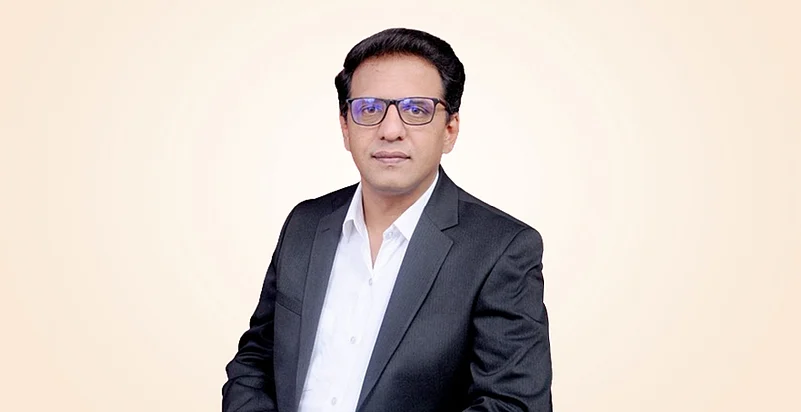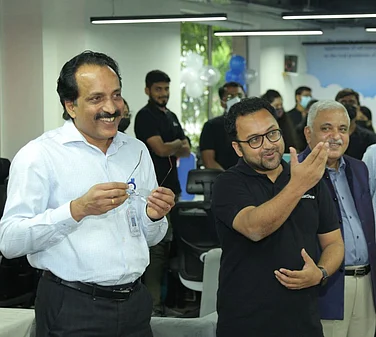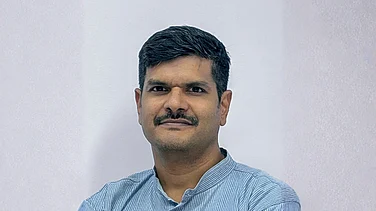Foreign capital outflow, sky-high valuations, mixed earnings seasons and volatility caused by the upcoming US elections, a lot does not seem to go well for the Indian stock market right now. So far in October, BSE Sensex has declined by more than 5 per cent or nearly 5,000 points. NSE Nifty50 has also been on a similar trajectory.
Just 2-3 months back, India seemed one of the top investing destinations among emerging markets before witnessing a sharp downturn. While investor sentiment remains jittery, D-street analysts are still betting on India's long term story.
In an exclusive interview with Outlook Business, Deepak Ramaraju, Fund Manager at Shriram AMC said that it is unlikely for markets to witness a severe downturn from a long-term perspective. The recent slowdown may set a 'new normal' for growth, which is just an adjustment phase before things regain momentum.
With massive foreign capital outflow causing volatility, markets are clearly not looking good Given your insights from the front lines of the market, what do you think is happening, and when do you expect stabilization?
A major factor contributing to the FII outflows is the upcoming US elections. This uncertainty is the epicenter of the current market volatility. While geopolitical tensions might not have an immediate or significant impact, the elections are certainly driving the outflows. I believe that clarity will emerge once we know the election results and the policies the new administration will implement. Until then, I expect the outflows to continue.
Plus, macroeconomic conditions and earnings reports are also influencing the situation. We’re currently seeing mixed earnings results, with some companies struggling to meet expectations. This combined with elevated valuations, is leading to further corrections in certain cases. However, it’s worth noting that this presents opportunities for domestic institutional investors (DIIs), who have been actively buying into the market during these dips. We can expect the situation to stabilize once the US elections conclude, as it can provide clarity to the policy picture.
With high PE ratios, are DIIs overextending by buying pricey stocks despite foreign outflows?
It’s not quite accurate to say that DIIs are overextending themselves. Their buying is occurring in specific pockets, and the absorption is happening gradually. Many DIIs have held these stocks for a long time, and their current purchases are incremental additions that will average out over time.
Plus, domestic investors generally adopt a long-term perspective and are not focused on short-term gains. In the long run, as rate cuts occur in India, the bull market is likely to return. While the current market might appear expensive from a short-term valuation perspective, when considering India’s long-term growth potential and sustainability, this may not significantly impact the DIIs' portfolios. Although it seems like they are buying at high prices now, if they hold these investments for three to five years, they could prove to be relatively cheap.
On a macro level, there are concerns around softening demand, falling rupee and high inflation. While some analysts are projecting a subdued festive season, others are maintaining a positive outlook. Where do you think this optimism is coming from?
In the recent quarter, the weakness we saw was partly seasonal due to the monsoon phase. We expect GDP growth to pick up in the third quarter. Historically, Q2 has always been a weaker period, so a slowdown here isn’t cause for much concern.
And as for festive demand, some sectors like the auto industry, did experience lower-than-expected growth. This was quite visible when Bajaj Auto released its earning figures. Despite subdued growth, the management indicated that growth is gradually rebounding. With major festivals occurring close together, the demand is expected to spread out over the season, so we may see the real impact once all festivities are over.
The consumption pattern has shifted, with more demand for premium products as consumers lean towards higher-end options. Financing availability is also high, with even those with lower credit scores able to access loans. While this brings some risk, the demand fundamentals remain strong.
So, while we may experience minor slowdowns in certain quarters, a severe downturn is unlikely. In the long run, rate cuts will boost demand, and any recent slowdown may set a “new normal” for growth—an adjustment phase before things regain momentum.
DIIs seem to have become saviours for the Indian market, trying to absorb some if not all the bloodbath caused by FII sell-off. How long do you think the DII confidence will last?
The primary factor driving the market now is liquidity. With investors moving away from fixed deposits, they are turning to real estate, gold or equity to get better returns as other assets aren’t offering significant yields.
If we talk about today’s investors, they have higher return expectations, which fuels more investment in equities. Then massive flows from instruments like NPS (National Pension Scheme) and EPF (Employees' Provident Fund) is also adding to the already high levels of liquidity in the market.
As for the valuation part, it is worth noting that India remains in growth phase. If we compare it with China's growth phase, which was during the late 1990s and early 2000s, our current valuation might not seem that high. Forward earnings and growth rates might moderate, leading to lower return expectations and a potential PE de-rating. While India is unlikely to become cheaper, it will remain relatively expensive due to liquidity.
If US cuts rates, foreign flows to India might increase, though not as significantly as before, since other emerging economies like China, Indonesia and Vietnam are also bring-in stimulus measures. The money will always get filtered out to those countries as well. But from a growth dividend, India is still better off from relative purpose.
How much cash are you holding right now?
We are currently holding less than 5 per cent of cash and are completely deployed. And we know that this fall is going to be temporary until elections which are not very far off. And we play the markets in a defensive way. So we have a defensive approach on the markets. I'm not taking any major arbitrage calls or kind of shorting the markets in a bigger way. We are just continuing to hold the positions and be neutral to the markets.
With SIP inflows holding steady at high levels, there’s plenty of money coming in but it sometimes seems like solid investment options are limited. Does it ever concern you that fund managers might struggle to find enough viable investments, which could end up pushing valuations even higher?
Yes, definitely. When there’s a large cash reserve and consistent new inflows, it can pose a challenge. While we’re not exactly facing that scenario at the moment since we’re fully deployed, the current valuation conditions can make it difficult to deploy funds effectively. Opportunities are there, but it requires a patient outlook, focusing on companies with solid earnings expectations and a willingness to invest with a longer time horizon.
For DIIs, the approach is typically long-term, not short-term gains. They look at growth prospects over several years, which allows for a more constructive view on quality companies with reputable management and strong fundamentals. Quality companies usually trade at a premium, and that’s normal. These companies are still investable if one is looking at a long-term perspective.
While PE ratio always remains on top during discussions around valuation metrics, what is the one metric that best reflects the valuation of an asset?
The PE ratio often dominates valuation discussions, but personally, I find it limited in assessing broader market valuations. PE is a universal measure, but how relevant it is depends on how companies manage their top line and earnings in the P&L. For top-line-driven sectors like consumer services, market cap-to-sales is more meaningful, and for company valuation, price-to-book can often provide a more accurate picture than PE.
For country-level valuations, I prefer the market cap-to-GDP ratio. Market cap reflects not only company valuations but also broader economic sentiment, liquidity, and fund flows—factors that contribute to a holistic valuation picture. India, for instance, trades at a premium to other emerging markets due to its growth potential, which justifies this measure.




























